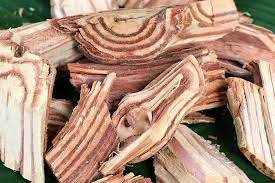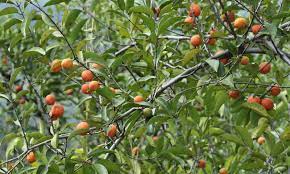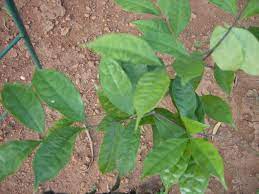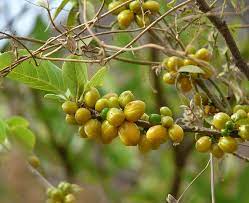Salacia reticulata, commonly known as Ceylon oak, is a tropical tree species native to Southeast Asia, particularly found in countries like India, Sri Lanka, and Malaysia. Belonging to the Celastraceae family, it is renowned for its medicinal properties and cultural significance in traditional medicine systems.
The Ceylon oak typically grows to a moderate height, reaching up to 15 meters tall, with a spreading canopy of glossy, dark green leaves. Its trunk is often twisted or gnarled, adding to its aesthetic appeal. The tree produces small, inconspicuous flowers that develop into round fruits, which turn from green to red as they ripen.
In traditional medicine, various parts of Salacia reticulata have been used to treat a range of health conditions, including diabetes, arthritis, and digestive disorders. The bark and roots of the tree contain bioactive compounds with potential therapeutic effects, leading to its use in herbal remedies and dietary supplements.
Cultivation of Ceylon oak is relatively straightforward, as it thrives in warm, tropical climates with well-drained soil and ample sunlight. The tree is drought-tolerant once established, making it suitable for cultivation in regions with irregular rainfall patterns.
Beyond its medicinal properties, Salacia reticulata holds cultural significance in the regions where it grows. It is often revered for its symbolism and spiritual associations, featuring in traditional rituals and ceremonies.
Overall, Ceylon oak is a valuable tree species with both medicinal and cultural importance. Its striking appearance, along with its potential health benefits, makes it a cherished component of tropical landscapes and traditional medicine systems.
Whether admired for its aesthetic qualities or utilized for its therapeutic properties, Salacia reticulata remains a treasured species in the regions it inhabits.
The Botanical Description of Salacia reticulata
1. Leaf Structure: Salacia reticulata features elliptical to oblong leaves with a glossy green color and prominent veins. The leaves are arranged alternately along the stems and have smooth margins.
2. Flower Appearance: The plant produces small, inconspicuous flowers that are pale yellow or greenish-white in color. These flowers are typically clustered together in axillary or terminal inflorescences.
3. Plant Height: Salacia reticulata is a woody vine that can reach lengths of up to 10 meters. It often climbs on nearby trees or structures for support.
4. Stem Characteristics: The stems of Salacia reticulata are slender, flexible, and often have a twisted or twining growth habit. They may be green or brownish in color.
5. Root System: The plant has a fibrous root system that spreads horizontally in the soil, anchoring the vine and absorbing water and nutrients.
6. Petal Arrangement: The flowers of Salacia reticulata have five sepals and five petals arranged in a radial symmetry. They are often inconspicuous due to their small size.
7. Flowering Season: Salacia reticulata typically blooms during the warmer months of the year, with peak flowering occurring in late spring to early summer.
8. Fruit Characteristics: The plant produces small, round fruits that turn from green to red as they ripen. These fruits contain one or more seeds and have a fleshy pulp when mature.
9. Sunlight Preference: Salacia reticulata thrives in full sun to partial shade, although it may tolerate a range of light conditions.
10. Geographic Origin: Salacia reticulata is native to tropical and subtropical regions of Asia, including parts of India, Sri Lanka, and Southeast Asia.
The Geographic Distribution of Salacia reticulata

1. Native Habitat: Salacia reticulata is commonly found in a variety of habitats, including tropical rainforests, deciduous forests, and scrublands.
2. Regional Distribution: The plant is native to various countries in Asia, including India, Sri Lanka, Thailand, Malaysia, and Indonesia.
3. Altitude Range: Salacia reticulata can be found at a range of altitudes, from sea level to higher elevations in mountainous regions.
4. Soil Preferences: The plant prefers well-drained soils with adequate moisture content, although it may tolerate a range of soil types, including sandy, loamy, and clay soils.
5. Climatic Conditions: Salacia reticulata thrives in warm, humid climates with consistent rainfall throughout the year. It may not tolerate extended periods of drought or extreme cold.
6. Human Introduction: In some regions, Salacia reticulata has been introduced for ornamental purposes or as a medicinal plant.
7. Invasive Potential: Due to its aggressive growth and ability to climb on nearby vegetation, Salacia reticulata has the potential to become invasive in certain habitats, displacing native plants.
8. Ecological Role: The plant provides habitat and food for various wildlife species, including insects, birds, and small mammals.
9. Conservation Status: While Salacia reticulata is not considered globally threatened, habitat loss and degradation pose potential risks to local populations.
10. Human Uses: Salacia reticulata has been used in traditional medicine for its purported health benefits, including the treatment of diabetes, obesity, and digestive disorders.
11. Urban Adaptability: The plant can thrive in urban environments, where it is often cultivated in gardens, parks, and botanical collections for its ornamental value and medicinal properties.
12. Naturalization: In some areas, Salacia reticulata has escaped cultivation and become naturalized in the wild, where it may compete with native vegetation for resources.
The Chemical Composition of Salacia reticulata
1. Salacinol: Salacia reticulata contains salacinol, a compound that inhibits the absorption of carbohydrates in the intestines, potentially reducing postprandial glucose levels.
2. Kotalanol: Another bioactive compound found in Salacia reticulata is kotalanol, which also inhibits carbohydrate digestion and absorption, contributing to its antidiabetic effects.
3. Polyphenols: Salacia reticulata contains various polyphenolic compounds, including flavonoids and phenolic acids, which have antioxidant and anti-inflammatory properties.
4. Triterpenoids: The plant contains triterpenoid compounds that may have hepatoprotective effects, supporting liver health and function.
5. Alkaloids: Alkaloids found in Salacia reticulata may contribute to its medicinal properties, although their specific roles and effects are not well understood.
6. Glycosides: Salacia reticulata contains glycoside compounds that may have cardiovascular benefits, such as reducing blood pressure and cholesterol levels.
7. Saponins: Saponins present in Salacia reticulata may have cholesterol-lowering effects and potential benefits for digestive health.
8. Essential Oils: The plant may produce essential oils with aromatic properties and potential therapeutic uses, although research on this aspect is limited.
9. Resins: Salacia reticulata contains resins that may have antimicrobial and wound-healing properties when applied topically.
10. Lignans: Some varieties of Salacia reticulata may contain lignan compounds, which have antioxidant and estrogenic effects and may benefit hormonal health.
11. Vitamins and Minerals: Salacia reticulata may contain vitamins and minerals, including vitamin C, vitamin E, and potassium, which contribute to its nutritional value and potential health benefits.
12. Polysaccharides: The plant contains polysaccharides, which may have immunomodulatory effects and support immune function.
13. Amino Acids: Salacia reticulata may contain amino acids, the building blocks of proteins, which play essential roles in various physiological processes in the body.
Read Also: 17 Medicinal Health Benefits Of Lotus Seed (Nelumbo nucifera)
The Medicinal Health Benefits Of Salacia reticulata (Ceylon oak)

1. Diabetes Management: Salacia reticulata has long been used in traditional medicine for its potential to help manage diabetes. It contains compounds like salacinol and kotalanol, which inhibit carbohydrate digestion and absorption, leading to lower blood sugar levels after meals.
2. Weight Management: Some studies suggest that Salacia reticulata may aid in weight management by reducing the absorption of dietary fats and carbohydrates, potentially supporting weight loss efforts.
3. Digestive Health: Salacia reticulata is believed to have digestive benefits, including relieving symptoms of indigestion, bloating, and gas. It may also support overall digestive function and promote regularity.
4. Anti-inflammatory Properties: Certain compounds found in Salacia reticulata possess anti-inflammatory properties, which may help reduce inflammation in the body and alleviate symptoms of inflammatory conditions such as arthritis and inflammatory bowel disease.
5. Antioxidant Activity: The plant contains polyphenolic compounds with antioxidant properties, which help neutralize harmful free radicals and protect cells from oxidative damage. This antioxidant activity may contribute to overall health and wellness.
6. Cardiovascular Support: Salacia reticulata may have cardiovascular benefits, including lowering blood pressure, reducing cholesterol levels, and improving blood vessel function, thereby reducing the risk of heart disease and stroke.
7. Liver Health: Some research suggests that Salacia reticulata may support liver health by promoting detoxification processes, reducing inflammation, and protecting against liver damage caused by toxins or oxidative stress.
8. Immune Modulation: Compounds found in Salacia reticulata may have immunomodulatory effects, enhancing the body’s immune response and potentially reducing the risk of infections.
9. Cognitive Function: Preliminary studies suggest that Salacia reticulata may have neuroprotective effects and could potentially support cognitive function and brain health, although more research is needed in this area.
10. Skin Conditions: Topical application of Salacia reticulata extract may help soothe and heal various skin conditions, including eczema, psoriasis, and acne, due to its anti-inflammatory and antimicrobial properties.
11. Anticancer Potential: Some research indicates that Salacia reticulata may have anticancer properties, inhibiting the growth and proliferation of cancer cells, although more studies are needed to confirm these effects.
12. Respiratory Health: Salacia reticulata may have benefits for respiratory health, including relieving coughs, reducing congestion, and supporting overall respiratory function.
13. Antimicrobial Activity: Compounds found in Salacia reticulata may exhibit antimicrobial effects against a range of pathogens, including bacteria, fungi, and viruses, making it potentially useful for treating infections.
14. Bone Health: Preliminary studies suggest that Salacia reticulata may support bone health by promoting bone formation and density, potentially reducing the risk of osteoporosis and bone fractures.
15. Anti-anxiety Effects: Some anecdotal evidence suggests that Salacia reticulata may have calming and anxiolytic effects, promoting relaxation and reducing stress and anxiety levels.
16. Menstrual Support: Traditional uses of Salacia reticulata include regulating menstrual cycles, reducing menstrual cramps, and alleviating symptoms of premenstrual syndrome (PMS).
17. Antiallergic Activity: Salacia reticulata may help alleviate allergic reactions by modulating immune responses and reducing the release of histamine, potentially providing relief from allergy symptoms.
The Methods of Usage to Achieve the Provided Health Benefits Of Salacia reticulata (Ceylon oak)
1. Herbal Tea: Brewing dried Salacia reticulata leaves or root bark into a tea for oral consumption, providing a convenient way to ingest its beneficial compounds.
2. Capsules or Tablets: Taking standardized Salacia reticulata supplements in capsule or tablet form, ensuring precise dosage and easy administration, especially for individuals who prefer a convenient option.
3. Tinctures: Using liquid extracts of Salacia reticulata orally, either alone or mixed with water or juice, for convenient consumption and absorption of its beneficial compounds.
4. Topical Applications: Applying Salacia reticulata extract or ointments topically to the skin to treat various skin conditions, providing relief from inflammation, irritation, and microbial infections.
5. Culinary Uses: Incorporating fresh or dried Salacia reticulata leaves or root bark into culinary dishes such as teas, soups, stews, and sauces for added flavor and potential health benefits.
6. Mouthwash or Gargle: Rinsing the mouth and throat with a diluted Salacia reticulata infusion or tincture to promote oral health, relieve sore throat symptoms, and reduce oral inflammation.
7. Poultices: Applying crushed or powdered Salacia reticulata leaves or root bark directly to the skin as a poultice to treat wounds, bruises, and skin irritations, promoting healing and reducing inflammation.
8. Inhalation: Inhaling steam from a pot of hot water infused with Salacia reticulata extract or essential oil to alleviate respiratory congestion, soothe coughs, and promote easier breathing.
9. Bath Soaks: Adding Salacia reticulata extract or infusion to bathwater to promote relaxation, soothe muscle aches and pains, and support overall well-being.
10. Dietary Supplement: Including Salacia reticulata supplements as part of a balanced diet to ensure adequate intake of its beneficial compounds and support overall health and wellness.
11. Compresses: Soaking a clean cloth in diluted Salacia reticulata infusion or tincture and applying it to inflamed or injured areas of the body to reduce swelling, alleviate pain, and promote healing.
12. Aromatherapy: Using Salacia reticulata essential oil in aromatherapy practices such as diffusing or inhaling its aroma to promote relaxation, reduce stress, and uplift mood.
The Side Effects Of Using Salacia reticulata Medicinal Plant
1. Gastrointestinal Distress: Some individuals may experience mild stomach upset, nausea, or diarrhea when using Salacia reticulata, especially in higher doses or sensitive individuals.
2. Hypoglycemia Risk: Salacia reticulata may lower blood sugar levels, leading to hypoglycemia in individuals taking antidiabetic medications or those with diabetes. Close monitoring of blood glucose levels is recommended.
3. Allergic Reactions: In rare cases, allergic reactions to Salacia reticulata may occur, presenting as itching, rash, hives, or difficulty breathing. Discontinue use and seek medical attention if allergic symptoms develop.
4. Drug Interactions: Salacia reticulata may interact with certain medications, including antidiabetic drugs, blood thinners, and immunosuppressants, potentially altering their effectiveness or increasing the risk of adverse effects.
5. Liver Toxicity: Prolonged or excessive use of Salacia reticulata may potentially lead to liver toxicity or damage, especially in susceptible individuals or those with pre-existing liver conditions.
6. Pregnancy and Breastfeeding: The safety of Salacia reticulata during pregnancy and breastfeeding has not been established. Pregnant or lactating women should avoid using the plant to prevent potential adverse effects on maternal and fetal health.
7. Hormonal Effects: Some compounds found in Salacia reticulata may have hormonal effects, potentially affecting hormone levels or hormone-sensitive conditions such as estrogen-sensitive cancers.
8. Respiratory Irritation: Inhaling dust or airborne particles from Salacia reticulata may irritate the respiratory tract in sensitive individuals, leading to coughing, wheezing, or shortness of breath.
9. Skin Sensitivity: Topical application of Salacia reticulata extract may cause skin irritation or allergic reactions in some individuals, especially those with sensitive skin or existing skin conditions.
10. Central Nervous System Effects: Some users may experience dizziness, headache, or drowsiness when using Salacia reticulata, especially at higher doses or in combination with other medications or substances.
11. Cardiovascular Effects: Salacia reticulata may affect blood pressure and heart rate, leading to changes in cardiovascular function or symptoms such as palpitations or chest pain in susceptible individuals.
12. Renal Effects: Prolonged use of Salacia reticulata may potentially affect kidney function or lead to renal toxicity, especially in individuals with pre-existing kidney conditions or those taking nephrotoxic medications.
13. Endocrine Disruption: Certain compounds in Salacia reticulata may disrupt endocrine function, potentially affecting hormone balance and reproductive health in both men and women.
14. Neurological Effects: In rare cases, Salacia reticulata may cause neurological symptoms such as tremors, seizures, or confusion, especially with prolonged or excessive use.
15. Immune Suppression: Long-term use of Salacia reticulata may suppress immune function or alter immune responses, increasing the risk of infections or compromising overall health.
Read Also: Hookworms: Description, Damages Caused, Control and Preventive Measures
The Scientific Research and Studies of Salacia reticulata

1. Antidiabetic Effects: Research studies have investigated the potential of Salacia reticulata in managing diabetes. Some clinical trials have demonstrated its ability to lower postprandial glucose levels and improve insulin sensitivity in individuals with type 2 diabetes.
2. Anti-inflammatory Properties: In vitro and animal studies have shown that Salacia reticulata extracts possess anti-inflammatory effects by inhibiting pro-inflammatory cytokines and enzymes involved in inflammatory pathways. These findings suggest its potential use in treating inflammatory conditions such as arthritis and inflammatory bowel disease.
3. Antioxidant Activity: Several studies have reported the antioxidant properties of Salacia reticulata extracts, which help scavenge free radicals and protect cells from oxidative damage. This antioxidant activity may contribute to its various health benefits, including cardiovascular protection and anti-aging effects.
4. Lipid-lowering Effects: Animal studies have indicated that Salacia reticulata supplementation may help reduce cholesterol levels and improve lipid profiles by inhibiting cholesterol absorption and synthesis. These findings suggest its potential use in managing dyslipidemia and reducing the risk of cardiovascular diseases.
5. Hepatoprotective Effects: Some research has suggested that Salacia reticulata extracts may have hepatoprotective properties by reducing liver inflammation, oxidative stress, and lipid accumulation. These effects could potentially benefit individuals with liver diseases such as non-alcoholic fatty liver disease (NAFLD) and hepatitis.
6. Antimicrobial Activity: In vitro studies have demonstrated the antimicrobial activity of Salacia reticulata extracts against various bacteria, fungi, and viruses. These findings suggest its potential use as a natural antimicrobial agent for treating infections and promoting wound healing.
The Safety Precautions and Recommendations In Using Salacia reticulata Medicinal Plant
1. Consult Healthcare Provider: Before using Salacia reticulata or any herbal supplement, individuals should consult with a healthcare provider, especially if they have underlying health conditions, are pregnant or breastfeeding, or are taking medications.
2. Start with Low Doses: It is advisable to start with low doses of Salacia reticulata and gradually increase as tolerated to assess individual tolerance and minimize the risk of adverse effects.
3. Monitor Blood Sugar Levels: Individuals with diabetes or those taking antidiabetic medications should closely monitor their blood sugar levels when using Salacia reticulata, as it may interact with these medications and affect glucose levels.
4. Watch for Allergic Reactions: Individuals with known allergies to plants in the Hippocrateaceae family or those with pollen allergies should exercise caution when using Salacia reticulata and watch for signs of allergic reactions.
5. Avoid Excessive Consumption: Excessive consumption of Salacia reticulata or high doses may lead to adverse effects such as gastrointestinal upset, hypoglycemia, or liver toxicity. It is essential to follow recommended dosages and usage guidelines.
6. Discontinue Use if Adverse Effects Occur: If any adverse effects occur while using Salacia reticulata, such as gastrointestinal discomfort, allergic reactions, or changes in health status, discontinue use immediately and seek medical attention if necessary.
7. Store Safely: Store Salacia reticulata supplements or products in a cool, dry place away from direct sunlight and moisture to maintain their potency and quality over time.
8. Use with Caution During Pregnancy and Breastfeeding: Pregnant or breastfeeding women should avoid using Salacia reticulata due to limited safety data and potential risks to maternal and fetal health.
9. Educate Yourself: Before using Salacia reticulata or any herbal remedy, individuals should educate themselves about its potential benefits, risks, and proper usage to make informed decisions about their health and wellness.
10. Quality Assurance: Choose reputable brands and products that undergo quality testing, adhere to Good Manufacturing Practices (GMP), and provide clear labeling with dosage information and safety precautions.
11. Keep Out of Reach of Children: Store Salacia reticulata supplements and products out of reach of children to prevent accidental ingestion and ensure safety in the household.
12. Report Adverse Events: If any adverse events or side effects are experienced while using Salacia reticulata, individuals should report them to healthcare providers and regulatory authorities for further investigation and monitoring.
FAQs About Salacia reticulata Medicinal Plant
1. What is Salacia reticulata?
Salacia reticulata is a tropical plant native to Asia, known for its traditional medicinal uses and potential health benefits.
2. What are the common names of Salacia reticulata?
Salacia reticulata is commonly known as “Kotala himbutu” in Sinhala, “Ponkoranti” in Bengali, and “Ponkoranti” or “Ponkara” in Tamil.
3. What are the medicinal health benefits of Salacia reticulata?
Salacia reticulata is believed to have various medicinal properties, including antidiabetic, anti-inflammatory, antioxidant, lipid-lowering, hepatoprotective, and antimicrobial effects.
4. How is Salacia reticulata used medicinally?
Salacia reticulata can be consumed orally as a tea, supplement, or tincture, applied topically to the skin, or used in culinary dishes for its potential health benefits.
5. Is Salacia reticulata safe for everyone to use?
While Salacia reticulata is generally considered safe for most individuals when used in appropriate doses, certain precautions should be taken, especially for pregnant or breastfeeding women, individuals with diabetes, or those taking medications.
6. Can Salacia reticulata help with diabetes management?
Some research suggests that Salacia reticulata may help manage diabetes by lowering blood sugar levels and improving insulin sensitivity, although more studies are needed to confirm its effectiveness.
7. Are there any side effects associated with Salacia reticulata?
Potential side effects of Salacia reticulata may include gastrointestinal upset, hypoglycemia, allergic reactions, liver toxicity, and interactions with medications.
8. How should Salacia reticulata supplements be taken?
Salacia reticulata supplements can be taken orally with water or food according to the manufacturer’s recommended dosage, typically one to three times daily.
9. Can Salacia reticulata be used topically for skin conditions?
Yes, Salacia reticulata extracts or ointments can be applied topically to the skin to treat various skin conditions, including eczema, psoriasis, acne, and wounds.
10. Is there scientific research supporting the health benefits of Salacia reticulata?
Yes, several scientific studies and research articles have investigated the medicinal properties and potential health benefits of Salacia reticulata, although more research is needed to fully understand its mechanisms of action and therapeutic effects.
Read Also: How To Raise Chickens – The Simple Secrets To A Great Backyard Flock

